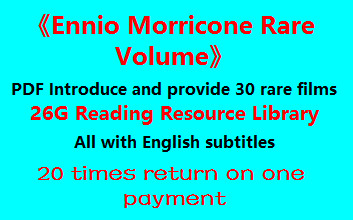LA CLASSE OPERAIA VA IN PARADISO (1971)
La Classe Operaia Va In Paradiso – known variously in English as The Working Class Goes To Heaven and Lulu the Tool – is a political drama directed by Elio Petri. The film stars Gian Maria Volonté as Lulù Massa, a worker at a factory whose extreme efficiency is used as an excuse by his bosses to pay his colleagues less and expect higher productivity from them. When Lulù loses a finger in an accident at work, and suddenly finds himself subject to the same uncaring work conditions as his colleagues, he begins to realize that he has been used as a ‘tool’ by the capitalist system, and begins to work with unionists and students to demand better treatment.
Morricone scored several of these left-wing pro-union dramas, and many of them feel similar. La Classe Operaia Va In Paradiso may be the best of them, combining a full orchestra with the I Cantori Moderni Di Alessandroni choir and the usual array of offbeat sound design for which he was so famous. The main title, “La Classe Operaia Va In Paradiso,” is an unusual staccato march that incorporates bizarre sound effects – duck quacks, highly processed gunfire that often morphs into a fluttering effect – against a vaguely comedic trumpet line and rapped snares, that becomes robust and rhythmic as it progresses; the repetitive nature of the theme is clearly commenting on Lulù’s place as a cog in a highly mechanized industrial machine, while the highly classical violin phrases that come in from time to time offer a lyrical counterpoint to the idea, romanticizing the freedom from the capitalist system for which the unionists fight.
Many of these ideas are expanded upon in the 8-minute “Sinfonia dell’Ottimista,” which is if anything even more abstract and challenging than the main title with it’s extended periods of texture and dissonance, although Morricone does return to the main theme regularly. “Metamorfosi,” “Tempi di Lavorazione” amd “Alienazione” are similarly bizarre, repeating the main title rhythms against an aggressive, brutal-sounding electric guitar throb and more unsettling orchestral textures that move in and out of the piece. “Il Sogno” is a challenging piece that mostly pairs stark woodwind effects with the fluttering gunfire idea, but then morphs into a disquieting textural piece for piano, low strings, and low brass. Really, only “Pazzia da Lavoro” offers any real diversity from this core sound, initially juxtaposing a dance-like mandolin motif against threatening brass chords, before eventually offering a large scale statement of the rhythmic part of the main title theme for percussion, piano, and sly strings.
La Classe Operaia Va In Paradiso is a tough score to love, although Morricone clearly did as it features regularly in his concert repertoire, confounding those who only turned up to hear The Mission and Cinema Paradiso. However, if this sort of aggressive Morricone experimentalism has always been fascinating to you, the score has been released numerous times over the years; the version I’m writing about here is the 2009 limited edition from the Italian label GDM, which takes the original 8-track LP album presentation and expands it to more than an hour, with several variations on the core material.
Track Listing: 1. La Classe Operaia Va In Paradiso (5:20), 2. Metamorfosi (2:10), 3. Sinfonia dell’Ottimista (8:16), 4. Inventario (2:58), 5. Tempi di Lavorazione (4:06), 6. Il Sogno (4:36), 7. Pazzia da Lavoro (2:23), 8. Alienazione (3:45), 9. La Classe Operaia Va In Paradiso #2 (3:46), 10. Metamorfosi #2 (1:55), 11. Sinfonia dell’Ottimista #2 (10:30), 12. Alienazione #2 (5:45), 13. Inventario #2 (2:24), 14. La Classe Operaia Va In Paradiso #3 (6:24). GDM Club 7062, 64 minutes 18 seconds.












